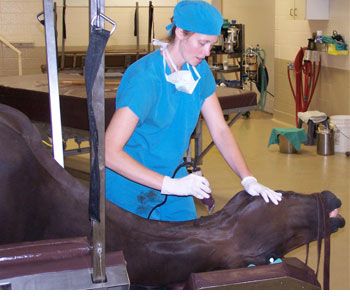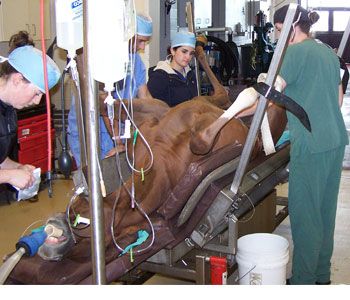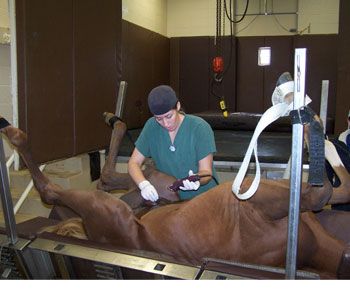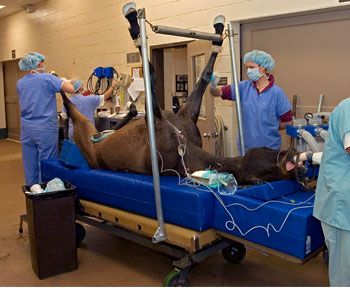PHOTOS: Equine veterinary technicians at work
See surgical technicians preparing an equine patient, and find out how the skills that make small animal veterinary technicians great work just as well in equine practice.
Next>

The work of licensed veterinary technicians in the small animal world gets lots of attention these days, but what about those technicians handling some of the biggest animals around—horses? Although the skill of the equine veterinary surgeon is most critical to a successful surgical outcome, the practitioner depends on veterinary technicians for assistance. Let's look at some of the ways equine technicians keep horses safe before, during, and after procedures.
Experience builds trust
It's no surprise that an equine veterinary technician with a solid education and well-rehearsed skills makes the equine practitioner's job easier, says Jennifer Stewart, LVT, at Hogan Equine at Fair Winds Farm in Cream Ridge, N.J. Proven aptitude breeds trust. "There is excellent confidence between the technicians and the equine practitioner [at Hogan Equine]," Stewart says. "It's trust that the technicians are extremely capable. I do the best I can to make the doctor's practice life as easy as I can."
Equine technician Rose Barwick agrees. "A technician's experience and familiarity with surgical procedures from beginning to end is essential," says Barwick, VN, EVN, DAVN (surgical), of VA-MD Regional Veterinary School's Marion duPont Equine Medical Center. "Anyone can run through a list of things to be done, but experience is important to pick up on the small essentials of what a particular surgeon 'likes' during surgery. Different surgeons like different instruments. Each may want the horse positioned in a particular manner. To know the idiosyncrasies of each veterinarian and to pre-empt that is very special. And it saves time because you're thinking ahead for what they need."
At Hagyard Equine Medical Institute, most surgical technicians are assigned to just one surgeon. "In that way we get used to that one surgeon's way of doing things—procedural wants and needs, communication style, particular quirks—so that we can best help," says surgical technician Stephanie Keeley at Hagyard Equine Medical Institute in Lexington, Ky.
Communication builds teamwork
"Communication in our practice is huge," says surgical supervisor and anesthesia technician Nicole Bone, LVT, at Rood & Riddle Equine Hospital in Lexington KY. "You have to be willing to take direction, and communicate with others very efficiently and effectively."
Communicating with doctors is crucial for equine technicians, says Keeley. "If not, things can fall apart. One of our many jobs is to verify the surgical schedule and make sure all the reports and X-rays are taken care of and presented to the surgeon and the anesthesiologist so make sure everyone is in the loop."
Sometimes all that communication can be a bit repetitive, Bone says, but it's worth it. Urgent messages are repeated at Rood & Riddle, a practice that sees a lot of emergencies—colic surgeries, fracture repairs and lacerations—that require immediate attention and quick response.
"A [veterinarian in the field] will call to tell us that a colic case is coming in 10 minutes," Bone says, and team members will hear that message from a number of co-workers. "But I'd rather have 20 people tell me the same thing than not tell me at all and have nothing ready."
Teamwork is essential when it takes many sets of hands to get large patients ready for procedures, Bone says. "Prior to surgery, to get a horse on the table and ready to go, it can take four or five technicians," she says. "Post-surgery, getting the horse to recovery, takes three to four people to push the horse to the recovery stall. Once the patient is on the mat, we have two recovery technicians monitoring and assisting the horse if necessary during the recovery period."
Time management builds better outcomes
"Time management skills are very important at our facility," Bone says. Her large-referral practice employs five surgeons who handle 20 to 40 surgeries per day. "Getting things done on time is critical," she says.
"Preparation is huge," Keeley says. "For example, if it’s a fracture surgery, that will need a cast post-surgically. It's not a good idea to get the material together after the fact. We want to get the horse off the table after the surgery as quickly as possible. If everything is ready to go, it takes less time to transition from surgery to casting."
Keeley says every good workday for her is built on communication, preparation, and teamwork. "Everything is better accomplished with those aspects working smoothly," she says.
Click on the following pages to see equine veterinary technicians at Hagyard Equine Medical Institute at work preparing an equine patient for a procedure.
Click here for a run-down of pre-surgery, surgery, and post-surgery steps for equine surgical technicians.
Ed Kane, PhD, is a researcher and consultant in animal nutrition. He is an author and editor on nutrition, physiology and veterinary medicine with a background in horses, pets and livestock. Kane is based in Seattle.

Veterinary technician Katie Fair shaves a patient preparing to undergo surgery for an umbilical hernia at Hagyard Equine Medical Institute in Lexington, Ky.
Photo courtesy of Ed Kane, PhD

A veterinarian and other technicians watch surgical technician Stephanie Keeley as she preps a patient to undergo surgery for an umbilical hernia at Hagyard Equine Medical Institute.
Photo courtesy of Ed Kane, PhD

Keeley shaves a patient preparing to undergo surgery for an umbilical hernia at Hagyard Equine Medical Institute.
Photo courtesy of Ed Kane, PhD

An equine patient is ready to undergo surgery for an umbilical hernia at Hagyard Equine Medical Institute in Lexington, Ky. One veterinarian and two equine surgical technicians are present.
Photo courtesy of Ed Kane, PhD